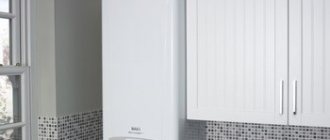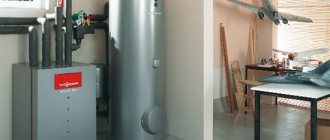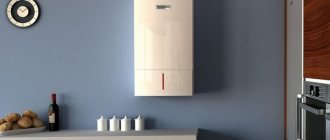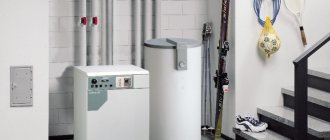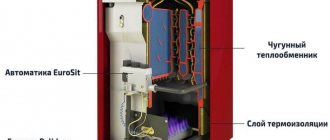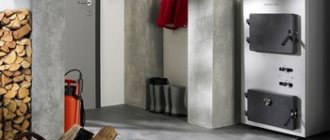The concept of a solid fuel cast iron boiler primarily implies the installation of a cast iron sectional heat exchanger in the boiler - the most important structural element that transfers the thermal energy of fuel combustion to the coolant. The properties and characteristics of the boiler unit as a whole depend on the material of manufacture of the heat exchanger and its design.
In the article we will look at all the differences between solid fuel boilers with a cast iron heat exchanger and analogues with a steel heat exchanger, and we will give a rating of the most successful modern models.
Advantages and disadvantages of cast iron boilers
The boiler heat exchanger is the material of the container in which the water will be located, and through which it will be heated from a heat source. The durability of the entire unit, as well as its efficiency, depends on this material. If the heat exchanger fails, then most likely the entire boiler will have to be replaced.
Cast iron is the most reliable and durable material. It is an alloy of iron and carbon. The iron in the alloy gives the ability to resist high temperatures, and the high carbon content gives strength, hardness and anti-corrosion properties. It is no coincidence that cast iron has long been used for forging fences, fences and kitchen utensils.
Advantages of cast iron boilers for home:
- Long service life: several decades.
- The material resists corrosion well and does not rust.
- There is almost no scale deposited on cast iron. A small layer forms over a long period of use and can be easily removed by simple washing.
- The boilers have several sections that can be changed individually. This increases the service life and reduces boiler repair costs.
- Thanks to the sectional structure, the amount of hot water can be increased by adding sections separately. That is, if an extension or another floor appears in the house, you can easily increase the power of the boiler room.
- Small size with high heat transfer.
A cast iron boiler is primarily designed for long-term and active use. It is best suited for houses where people live permanently.
This type of heat exchanger also has its disadvantages:
- Since cast iron is a very fragile and heavy material, these products are difficult to transport. During transportation they must be treated very carefully so as not to be damaged.
- Cast iron is very sensitive to temperature changes. If you pour cold water into a hot boiler, cracks will appear in it, which will entail replacing one or more sections.
- The price of cast iron boilers is much higher than that of steel ones. But the cost of the boiler pays off in several years. During the service life of one cast iron product, 3-4 steel units can be replaced.
If we compare the pros and cons, then a cast iron product turns out to be significantly more profitable with careful handling and careful operation.
Distinctive features of Russian-made long-burning solid fuel boilers
A distinguishing feature of Russian solid fuel (SF) boilers that is clear to everyone is their cost. At the same time, the quality of workmanship and fuel combustion efficiency, even in more complex long-burning models, increases every year, and prices for boilers remain practically unchanged - this is a fact.
Lower cost of boilers can be achieved due to cheaper labor, lower taxes, absence of duties for transportation across borders, cheaper components and lower costs for technology research, which undoubtedly affects the efficiency of boilers, but every year it is less noticeable.
Another characteristic feature is its adaptability to domestic operating conditions. These include less serious requirements for fuel (especially the fraction and degree of ash content of coal, moisture content of firewood), and in most cases, non-volatile automation. Volatile boilers often withstand voltage fluctuations; the absence of a voltage stabilizer is not critical.
The device is based on the example of the domestic long-burning boiler Teplodar Kupper.
However, domestically produced boiler units have a lower, on average 3-7%, efficiency. They have a narrower functionality; self-cleaning mechanisms are only rarely found.
Reviews of boiler units produced in Russia: advantages and disadvantages
| Advantages | Flaws |
| Cost – long-burning boilers made in Russia are on average 20-50% cheaper than foreign ones | Due to simpler technologies (alloy, design, operating principle, “smart” automation) they are less effective in comparison with foreign analogues |
| Practicality, simpler fuel and maintenance requirements | Cast iron models are made from relatively simple alloys with a rough surface that is more difficult to clean |
| Most models are universal and work on any type of solid fuel: wood, brown or coal, anthracite, pellets, peat briquettes | Poor design and build quality. In some models, a slight emission of smoke is possible (especially when the loading door is open) even with excellent chimney draft |
| Cheaper spare parts and overall service. Even in the regions there are enough competent specialists | Although long-lasting models pay for themselves in 3-7 years, one cannot help but note the higher fuel consumption compared to imported models |
| Low level of automation, less stable temperature level maintenance |
Types of cast iron boilers
Cast iron boilers are divided among themselves according to several parameters:
- Type of fuel
- Number of sections
- Type of installation.
Various models are available for wall or floor installation. Floor standing boilers usually have a larger volume. Most cast iron boilers are equipped with several sections for heating water. The boiler may contain from 2 to 4 sections.
Advice. When choosing a boiler, you should pay attention to its power. It is calculated from the formula: 1 kW per 0 square meters of heated area.
Boilers are also divided by type of fuel. The design of the equipment primarily depends on the type of fuel: wall thickness, fuel supply structure, boiler cooling system. Solid fuel and liquid fuel boilers are usually floor-standing, as they have a large combustion chamber.
Gas boilers are often produced as wall-mounted ones, which saves space in the boiler room. But large models can also be installed on the floor.
Important! When choosing a unit, you need to decide in advance what fuel will be used. There are models for 2-3 types of fuel, or which can receive heat from the electrical network and other fuel. Universal options are the most convenient.
Prices: summary table
| Manufacturer and model | power, kWt | Efficiency, % | Cost, rub. | Our rating (from 0 to 5 points) |
| Protherm Beaver 20 DLO | 19 | 90,2 | 79 000 | 4.8 |
| Viadrus Hercules U22 C-3 | 17,7 | 80 | 73 000 | 4.5 |
| Kentatsu Furst ELEGANT-03 | 17 | — | 36 000 | 4 |
| KChM -5-K-03M1 | 21 | 77,6 | 48 000 | 3.5 |
Gas boilers
Gas cast iron boilers are the most popular models, as they operate on the most accessible and cheap fuel. Such home heating will be the cheapest compared to central heating or the use of solid or liquid fuel for a private boiler room. Another advantage of gas fuel is a high degree of autonomy. The boiler room can operate on it for a long time; there is no need to add or add fuel. Only an electric boiler is more convenient in terms of autonomy.
Gas can be supplied to the boiler room either from a central gas pipeline, which will be the most convenient, or from cylinders. Bottled gas is not very convenient to use, since the fuel must be stored in a specially equipped place.
Installation of gas boilers is subject to strict requirements:
- Equip the ventilation and gas chimney of the boiler room.
- After installing the necessary equipment, the boiler room must be registered with the gas service.
- A gas boiler requires annual inspection and maintenance by the gas service. It costs approximately 500 rubles.
- If the gas is contained in cylinders, cutting them requires a separate room outside the house, with ventilated valves or doors.
Despite all the difficulties, many people choose a gas boiler because of the low cost of fuel.
4.3. TVG series hot water boilers
Cogeneration water heating boilers of the TVG series are produced with a heating capacity of 4 and 8 Gcal/h (4.7 and 9.4 MW). These sectional welded boilers are designed to operate on gas with water heating not exceeding 150 °C.
Rice. 4.2. Water heating boiler TVG-8 : a - water circulation diagram; o - boiler design; 1, 2 - lower and upper collectors of the convective surface, respectively; 3, 5 — ceiling-front pipes; 4, 6 - lower and upper collectors of the ceiling screen; 7 — left side screen; 8, 14 — two-light screens; 9 — right side screen; 10 - water outlet to the heating network; 11 — convective heating surface; 12 — radiation surface of the furnace; 13 — air channel; 15 — burners; 16 - sub-pod channels
In the TVG-8 water heating boiler, the radiation surface of the furnace 72 (Fig. 4.2) and the convective heating surface 77 consist of separate sections made of pipes with a diameter of 51 * 2.5 mm. In this case, in sections of the convective surface the pipes are located horizontally, and in sections of the radiation surface - vertically. The radiation surface consists of a front-ceiling screen and five sections of screens, three of which are double irradiated (two-light screens 8 and
The boiler is equipped with hearth burners 75, which are located between the sections of the radiation surface. Air from the fan enters the air channel from which it is supplied to the sub-channels connected to the burners. The fuel combustion products move along the pipes of the radiation surface, pass through the window in the rear part of the furnace and enter the lower shaft, washing the convective surface with a transverse flow. At the same time, water for heating enters the two lower collectors 7 of the convective surface and is collected in the upper collectors of the convective surface. Next, through several ceiling-front pipes, water is directed to the lower collector of the ceiling screen, from where it flows through the ceiling-front pipes to the upper collector of this (ceiling) screen. After this, the water sequentially passes through the pipes of the screens: the left side 7, three two-light and the right side. The heated water through the collector of the right side screen enters the outlet into the heating network.
Water heating boilers of the TV G series have an efficiency of 91.5%.
Electric boiler
This is the most convenient type of equipment, but also the most expensive. In any case, it is cheaper to connect central gas or central heating to the house. In addition, this type of boiler requires a powerful electrical connection - around 9-15 kW. Not every village has such networks.
On the contrary, in villages where there is a fairly powerful supply of electricity, as a rule, there is also the rest of the infrastructure: central heating, a gas pipeline or good roads. Therefore, an electric boiler, despite all its convenience, becomes less profitable.
Boilers for solid fuel
A solid fuel cast iron boiler runs on wood, coal, peat or special briquettes. These boilers are always installed on the floor due to their heavy weight and large combustion chambers.
The only convenience of this type of boiler is its ease of installation and use. The equipment does not need to be registered and maintained. You can heat it immediately after installation.
Solid fuel has low efficiency. It is also very inconvenient:
- Firewood must be stored somewhere so that it does not become damp. They need to be pricked and worn, and they are heavy.
- Coal also needs to be stored somewhere. But there is always a lot of dust flying from it.
- Coal and firewood must be regularly added to the combustion chamber. This must be done every few hours.
- Peat briquettes also generate dust and stain everything around. Peat briquettes can be thrown into the boiler much less often than firewood or coal. Such a boiler can operate all night without human intervention.
- Boilers require constant cleaning of soot.
Solid fuel becomes a good option when liquid or gas cannot be used. In addition, this is a good temporary option in case the gas in the house runs out or the electricity is turned off.
The best Russian manufacturers and models: characteristics and prices
Week KO-60
One of the most famous models with a peak power of 60 kW. However, the efficiency and duration of burning of a full load depends on the heated area. For 200-250 m2, the burning time is 2-4 days, while when heating a small house with an area of 100 m2, the boiler can operate for up to 7 days (on one full load - 160 liters or 15-16 buckets of coal).
However, the efficiency and combustion duration also strongly depend on the type of fuel used. Brown coal, which burns out in 2-3 days, is especially not recommended. The boiler is made of thick steel, which reacts faster to temperature changes and heats the water circuit faster, while the service life declared by the manufacturer is at least 20 years. In practice, there are already cases of problem-free service for more than 6 years.
Significant disadvantages are the huge weight (420 kg) and the high cost for a simple domestic TT boiler.
Price: 130,000 rub.
How and what kind of coal is best to heat a household solid fuel boiler
Teplodar Cupper PRO 22
Inexpensive, extremely reliable and efficient long-lasting boiler with a capacity of 22 kW. It has a built-in heating element, which allows you to significantly slow down the cooling process after burning out solid fuel or prevent freezing of the heating system. An excellent option is when the firewood burns out until midnight, and the heater continues to retain heat until the morning. Works on both wood and coal, you can install a pellet burner.
Due to the extremely affordable price, it also has a sufficient number of disadvantages associated with operation and maintenance. The combustion chamber has a volume of only 35 liters (versus 160 for Nedelka KO-60). When heating a house with an area of 100-160 m2, the burning time of wood is 6-7 hours, and coal - up to 10. It is quite inconvenient to lay firewood, they should have a length of no more than 35-40 cm. The cleaning process, due to the design, requires some effort.
NMK KVO MAGNUM 20 TE
A little-known, but worthy of attention, long-burning boiler with a power of 20 kW. It features an excellent, fast-heating water grate, economical fuel consumption with a full load burning time of up to 24 hours (firebox volume 79 l).
However, the boiler is designed for heating exclusively with coal; other types of fuel are not desirable, although they can be used as a temporary option. To heat an average house with an area of 100-130 m2, 3-5 buckets of coal per day are needed. It is possible to install additional heating elements for additional heating of the coolant.
Unlike many even foreign TT boilers, the model can operate uninterruptedly throughout the entire heating season, i.e. ash removal and partial cleaning does not require extinguishing and can be carried out during fuel combustion. No noticeable shortcomings were found in the practice of use; according to reviews from the owners, the boiler unit “works like a clock.”
Bastion M-KST-20 P
One of the best long-burning pyrolysis boilers made in Russia (20 kW). The pyrolysis principle of operation implies the presence of an additional combustion chamber in which the gases emitted by the fuel burned in the main furnace are burned. Thanks to this, it was possible to achieve an efficiency of 85%, which is quite a high figure for a domestic solid fuel boiler.
Designed for heating with coal, wood and wood briquettes. A combustion chamber with a volume of 70 liters allows the combustion of wood to last up to 4-5 hours, coal - up to 9-10 hours when fully loaded.
The disadvantages are a small, quickly filling ash pan, difficulty in cleaning and the constant formation of condensation (black tar), which can only be cleaned after the fuel has completely burned out. Despite its high efficiency, due to the difficulties of maintenance, it is better to choose a boiler for intermittent heating of a dacha or when people live in the house only occasionally. Otherwise, it is necessary to regularly stop the furnace for 1-1.5 hours and clean the boiler.
Cost: 38,000 rub.
Boilers with a burning duration of one load of fuel up to 7 days
Liquid fuel boilers
Liquid fuel boilers run on regular diesel, which is popularly called diesel fuel. The advantage of liquid fuel boilers is that there is no need to regularly add material to the combustion chamber. Just like gas fuel, diesel is supplied to the boiler automatically.
The disadvantage of such boilers is the high cost of fuel and the need to store it in a closed, warm room. Storing fuel in the house creates a fire hazard, and equipping a separate shed is expensive.
Liquid and solid fuel are convenient only as additional fuel, in case the electricity goes out or gas runs out.
But in any case, a cast-iron boiler in a house is convenient primarily because the building becomes autonomous from external highways, and therefore more comfortable.
4.5. Water heating boilers of the KV-TK series for chamber combustion of solid fuels
Boilers of the KV-TK series are designed for chamber combustion of solid pulverized fuel and have a U-shaped layout. Solid fuel dust is fed into six turbulent burners (Fig. 4.6), arranged in opposite directions, three burners on each of the side walls of combustion chamber 7. The boiler is designed with solid slag removal.
The walls of the combustion chamber 7, the rotary chamber and the rear screen are made of gas-tight pipes with a diameter of 60 x 4 mm with a pitch of 80 mm. To ensure gas tightness, strips of 20 x 6 mm are welded between the pipes. In the upper part of the combustion chamber, the pipes of the rear screen cover the inclined slope of the transition chamber and then, before entering the rotary chamber, are spread into a scallop. 2 Blowers are installed on the walls of the combustion chamber with compressed air supplied to them.
Two convective packages made of pipes with a diameter of 28 x 3 mm are installed in the convective shaft. Below them is a three-pass (air) air heater 5, made of pipes with a diameter of 40 x 1.5 mm, providing air heating up to 350 °C. To clean convective heating surfaces, a shot cleaning device (shot cleaning unit) is provided. The boiler is suspended from the frame by the upper collectors. The air heater rests on a separate frame. The boiler has a lightweight lining.

